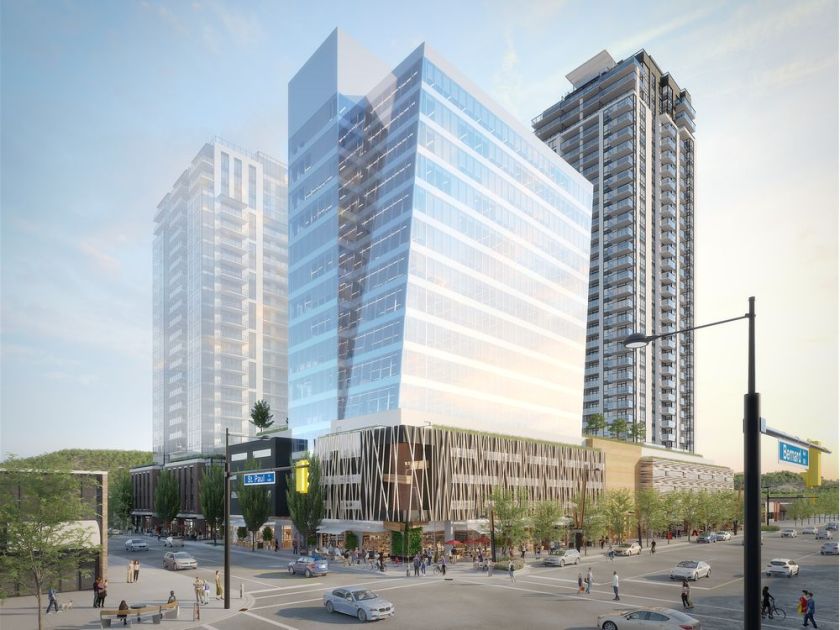Kelowna-based developer Mission Group has announced it is building a 16-storey office tower, The Block, at the corner of Bernard Ave. and St. Paul St., in the downtown core.
Two new tower projects in Kelowna are pushing the Okanagan city’s office market into a taller and bolder future.
Kelowna-based developer Mission Group has announced it is building a 16-storey office tower, The Block, at the corner of Bernard Ave. and St. Paul St., in the downtown core.
Pending permissions, The Block will include 85,000 square feet of class-A office space on levels six through 16, as well as four levels of parking and 16,000 sq. ft. of street-level retail.
It’s part of a 1.5-acre complex by Mission Group that also includes two residential towers, the Brooklyn, which is under construction and Bertram, which will launch for sales in the spring.
“We’re very bullish on Kelowna’s downtown in general,” said Luke Turri, executive vice-president with Mission Group. “In the past few years we’ve started to invest quite a bit in the historic core of downtown with residential condo towers. What we’ve seen in that time is certainly a maturing of Kelowna’s economy and also an enhanced interest in downtown Kelowna in general.”
He said pre-releasing has just launched on The Block and they expect to start construction this coming fall.
Meanwhile, construction work continues on Landmark 7, a 23-storey tower by Al Stober Construction that will add about 250,000 square feet to the Landmark District.
More than 3,500 people already work in buildings at the Landmark district in mostly technology, professional services, education and retail.
The building is part of a cluster of office towers that have risen in the district since 1994, creating a commercial district separate from downtown on the south side of Highway 97 between Burtch and Spall roads.
Landmark 7 is expected to complete in mid-2022.
Stephen Webber, an associate vice-president with Colliers International in Kelowna, said the two projects represent the most prominent office buildings currently being built or planned in the city, which has seen its office vacancy rate drop by about half in the last two years.
The local industrial, residential and office markets have all been strong and are fuelling the need for job space, but there has emerged a disparity between the various office classes, with older product getting emptied almost as soon as new product becomes available, Webber said.
The current vacancy rates are 1.7 per cent in class-A, 3.4 per cent in class-B and 7.3 per cent in class-C. Altogether the rate is 4.1 per cent for the Okanagan city of about 130,000, which is starting to claim technology as a major employer.
Overall, Kelowna has just under two million square feet of class-A office inventory across 46 buildings and a total office inventory of just under four million square feet, according to Colliers.
Webber said there will likely be an uptick in overall vacancy once Landmark 7 and The Block open in coming years. To what extent is unclear.
The typical users for the new space will include a mix of professional services and maybe tech companies.
In the 18 hours prior to speaking with Postmedia, Webber said he heard from an accounting firm from Calgary that was seeking office space as part of a move to Kelowna and from a small architecture firm from Alberta looking to relocate to Kelowna as soon as possible.
“That’s your typical kind of user,” he said. “The growth is still happening. The influx and new businesses that are opening and new businesses that are coming here have been absorbing (space) fairly steadily.”
Mission Group’s Turri sees his project as a major step for downtown core that hasn’t seen much new office space.
“To be able have that shared energy of the residential and the office and the supporting retail is just going to create a new presence in this part of the downtown,” he said.
Turri said it’s likely that the space will leased by several tenants, rather than to a single business.
“Certainly, we would make the building available for an entire floorplate or multiple floorplates should tenant demand go there,” he said.
